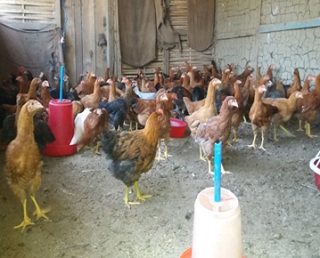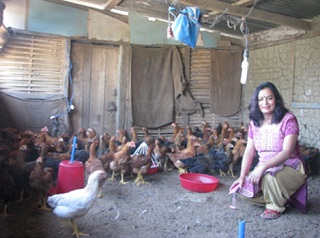Successful Vanaraja Backyard Poultry Farming Enterpreneur Under Intensive Condition from South Sikkim.
Vanaraja poultry is a dual purpose poultry breed developed by ICAR-Directorate of Poultry Research (DPR), Hyderabad. Due to the similarity in phenotypical appearance of the Vanaraja birds to the indigenous birds, it has been well accepted by the farmers of Sikkim. But their growth and egg production is far better than the local poultry breeds. There are some other reasons for the popularity of the birds in Sikkim like attractive multi colour feather, low maintenance cost, high disease resistance, and large brown coloured eggs resembling the local egg. Further, the birds consume insects and leafy grasses and plants if they are reared in backyard condition. Some farmers in Sikkim feed soft green leaves and grasses to the birds when they are reared in semi-intensive condition. The birds are very well acclimatized to the climate of Sikkim with good growth and moderate egg production as per the data generated in farmer’s field. The poultry has been performing well in all four districts of Sikkim. Erstwhile ICAR Sikkim Centre and now ICAR-National Organic Farming Research Institute (NOFRI) located at Tadong, Gangtok introduced Vanaraja poultry in 2010 under the Poultry Seed Project funded by ICAR-DPR, Hyderabad. Since inception, the birds have been popularized in all four districts of Sikkim with the technical intervention of ICAR-NOFRI. Vanaraja parent chicks are procured from DPR, Hyderabad and reared at the Poultry Unit of ICAR-NOFRI for production of fertile eggs and day old chicks are distributed to the farmers. Under the Tribal Sub Plan (TSP) component of the Project, the institute has been distributing free of cost Vanaraja day old chicks (DOC) to the tribal farmers of Sikkim. During the last financial year we have supplied 53,407 nos. of DOC to the farmers. Out of this 47,708 nos. of DOC have been supplied free of cost to tribal farmers under TSP project. Due to the intervention of ICAR-NOFRI, the rural farmers have been able to improve nutritional and livelihood security through the Vanaraja backyard poultry farming. There is a great demand of Vanaraja eggs in the urban, peri-urban and rural areas. The price of the egg varies from Rs. 10/- to Rs.20/- at different places in Sikkim. The people of Sikkim have well accepted the eggs of Vanaraja birds for consumption due to the resemblance with the local eggs. Farmers are greatly interested in rearing the birds both for egg and chicken meat production. During the current year also 25,000 Vanaraja birds have been distributed to the farmers. During the village visits for monitoring and advisory services, it has been observed that hen day egg production performance varied from 60 to 70% and Vanaraja adult bird weight ranged from 2.25 to 3.0 kg in females and 3.0 to 4.5 kg in males. An adult female layer lays 120 to 150 eggs per annum in Sikkim. The birds have been performing well in two districts viz., East and South District. The farmers are highly satisfied with the production performance of the Vanraja birds. Depending upon the price of the eggs and chicken meat the revenue generated from one bird varies greatly from place to place. The revenue generated by the farmers from each bird varies from Rs. 1800 to Rs. 2500 from the sale of eggs and finally the culled bird.
Most of the farmers in Sikkim practice poultry farming in backyard condition but some farmers have recently adopted intensive rearing of Vanaraja birds exclusively for chicken meat production and generate reasonable income within 3 to 4 months. The success story of Ms. Madhu Tiwari, lady entrepreneur from Temi Tarku, South Sikkim is praiseworthy. She has been raising the purchased Vanaraja birds for the last two years in a small low cost old house converted into poultry house for rearing of Vanaraja birds. The house is made up of locally available material like wood, mud, bamboo, roof sheet etc. The house barely accommodates 250 nos. of birds. The birds are raised by targeting the demand during the forthcoming important festivals. All the chicks are grown well on commercially available grower ration in exclusively intensive conditions. There is no separate labour requirement for the purpose. She attends the birds only for half an hour during morning and half an hour during evening for providing feed and water to the birds. With the minimal heath coverage like essential vaccinations and rare initial treatments and nutritional supplements, the birds are performing very well. Within a period of 3 months birds attain 1.7 to 3.0 kg body weight. She starts selling the birds at the age of 3 months and all the birds are sold out by 4 months of age. This way she rears 3 batches of Vanraja birds in a year. From each batch she earns more than Rs. 1 lakh after deducting all the management costs including the cost of the chicks. The programme is so planned that she places the requisition to ICAR-NOFRI for Vanaraja DOC well before time in order to rear three batches in a year. The lady is highly satisfied with the Vanaraja poultry farming in intensive conditions for chicken meat production and continuously does the business. Her net income per annum from the Vanaraja backyard poultry farming is more than Rupees three lakhs (Rs. 3.0 lakhs). She is always in touch with ICAR-NOFRI, Tadong for the technical support as and when required.
Vanaraja Birds reared in Intensive condition

